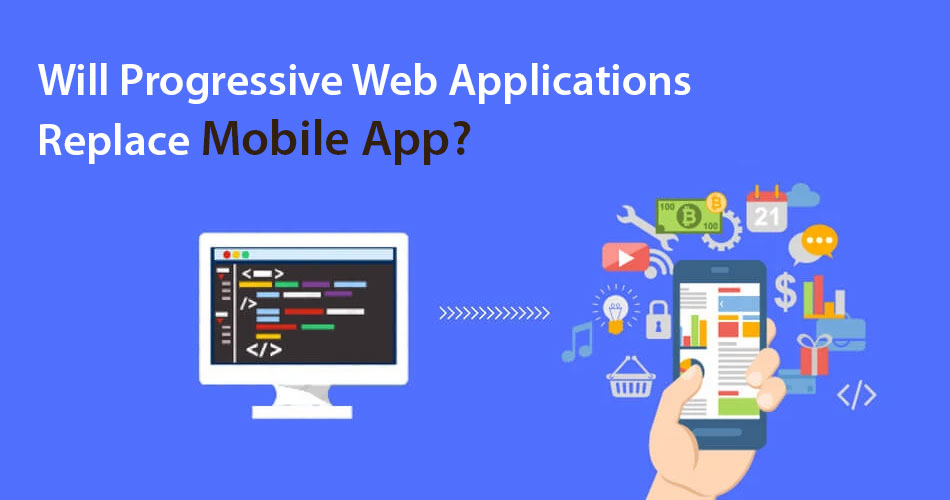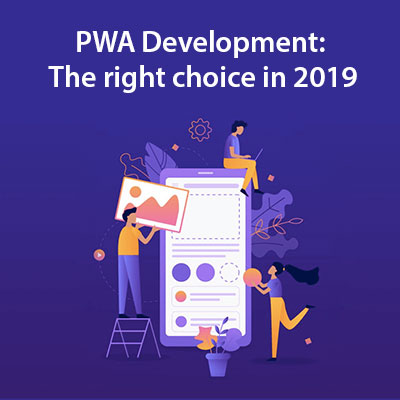
Well, this is really a difficult question to answer! The battle between mobile applications and PWA’s is on a high note.
Undoubtedly, native apps offer rich functionalities and benefits to the user as well as Admin. But creating a native app for a business is not an easy task to do, it requires a lot of monetary resources and it is a time-consuming process. Also, there is no surety that whether the users will accept your native application or not, will they really go to the play store to download and reserve their smartphone’s valuable space for your app, will your app rank in the app store, and so on.
Is building a native application will meet your business goals?
The usage and market of native apps have increased at a very fast rate over the years. The Apple app store was launched in the year 2008, with 500 live apps and others queued. And now, in 2019 there are 1.8 million apps available for Apple users and 2.1 million apps available for Android users. Obviously, native apps would be serving great features, this is the wholesome reason why millions of companies opted to invest in creating native apps for their business. But are they the right kind of app for your business in 2019?
Limitations suffered by native application
Despite all the finest offerings, native applications have certain limitations as well. Below are the few:
- Stops Impulsive Buying: The native apps can only be used when the user download and install it from the App Store, following a series of steps.
- Separate Coding for Android and iOS: The two different teams of developers need to be hired for developing native apps for both the platforms.
- Expensive Development and Maintenance cost: The app development cost totally varies according to their category like m-commerce, social networking, messaging application, etc. To know the actual development cost of a native app, talk to our experts. The maintenance cost is approx. 15- 20 % of the development cost.
- Eats a lot of time: Since different coding needs to be done for iOS and Android, developing a native app is a time-consuming process.
- Offline Mode: A native app is dead without internet connectivity. On the bad network, performance and speed degrade.
- Difficult to optimize for SEO: As native apps are created for smartphones only, promoted on Google Play store and iOS App Store, it’s difficult to optimize it for search engines.
PWA Development: The right choice in 2019

Keeping today’s technological advancement in mind, a simple business website would not be enough responsive in terms of user experience. On the other hand, the native applications will offer excellent user experience but it has certain device restrictions, connectivity, and storage issues plus it’s not easy to afford by a start-up and small sized business. The best solution for today’s business is to opt for PWA development.
Building Progressive Web Apps is a cost-effective way to grow and increase the conversion rates of the business. Progressive Web App offers a native app-like experience to the users, without losing its robustness as a website. PWA’s solves the major problems faced by the customer while using native apps.
Benefits offered by Progressive Web Apps
PWA’s offer Easy Offline Access
PWA’s can save the browsing data in the cache memory and use it in offline mode. The PWA website with a product catalog can be accessed by the user even without internet connection leading to increased user retention. On the other hand, if we run a native app in 2G speed, the speed and performance will be worst. Forget about no internet connection!
PWA’s are Search Engine Friendly
Crawling, creating and sharing unique URL, Indexing and applying other SEO techniques will enable the PWA website to improve its search engine presence and webpage ranking. This will help in increasing the website’s visibility, organic traffic, and good conversions. On the contrary, it is hard to optimize native apps for search engines.
Users need not to follow download and Installation process
To use the Progressive Web App, there’s no need to visit the Google Play store or Apple App store to install it. The user can easily create the website’s icon on the mobile’s home page screen, without the hassle of real download. While in the case of native apps, a user has to follow a series of steps which is a lengthy and time-consuming process. The PWA’s are easily accessible, efficient than native apps, and don’t eat up smartphone’s valuable space and data.
Offers Native App feel to the users
PWA websites offer app-style experience to the users. They run smoothly both as the web page and mobile app. PWA’s are highly user responsive, suitable for desktop, mobile, and tablet as well. On the contrary, native apps cannot run on desktop and they need to be built from scratch fulfilling the guidelines of different platform: Google Play and iOS app store.
PWA’s can send Push Notifications
With PWA Apps, the Admin can send short customize messages to the users to notify them about upcoming events, updated product features, and other information in the form of notifications. These push notifications help in increasing user engagement.
PWAs are economical
Finally, we come to the development and maintenance cost of building PWA. The cost of developing a PWA website is very much less as compared to creating native applications. The difference is so huge that it cannot be ignored by any business entity. PWA’s work on major browsers: Chrome, Firefox, and Safari. Because PWA’s offer wider accessibility, their development, and maintenance cost is affordable.
Progressive Web Apps are the future
How many native apps do you download in a week, or a month? Do you delete an old app when you download a new one?
Statistics show that 51 % of U.S smartphone users download zero apps per month. And 13% of US smartphone users download 1 app monthly. These numbers prove that users are turning away from mobile apps. From the pool of millions of apps, half of the U.S population is not even downloading a single app per month. Isn’t that strange?
From Forbes to Trivago, the big companies have opted PWA development technology and earning good revenues. After PWA development, your website will experience a magnificent change in page load speed.
- Twitter lite experienced a 65 % increase in pages per session, delivering about 10M push notifications a day, which arrives even if the user’s browser is closed.
- Forbe’s website loads in just 2.5 seconds after implementing PWA Development. The page load speed of Forbe’s old website was 6.5 seconds.
- Trivago’s PWA website is built in 33 languages, across 55 countries. After implementing PWA Development, half a million people have added Trivago’s website to their home screen, the user engagement increased by 150%.
Considering all the aspects, the importance and usage of native apps have been drastically affected after the introduction of Progressive Web Apps. A lot of big companies have already implemented PWA development to their website and they are really performing great in terms of user engagement and revenue. Other big ones are moving towards this new technology with open arms. With the increasing trend of PWA, most of the native apps will end up in a Progressive web format.
If your native application is facing severe challenges and you want to embrace this new technology: Progressive Web Apps, talk to our experts.
